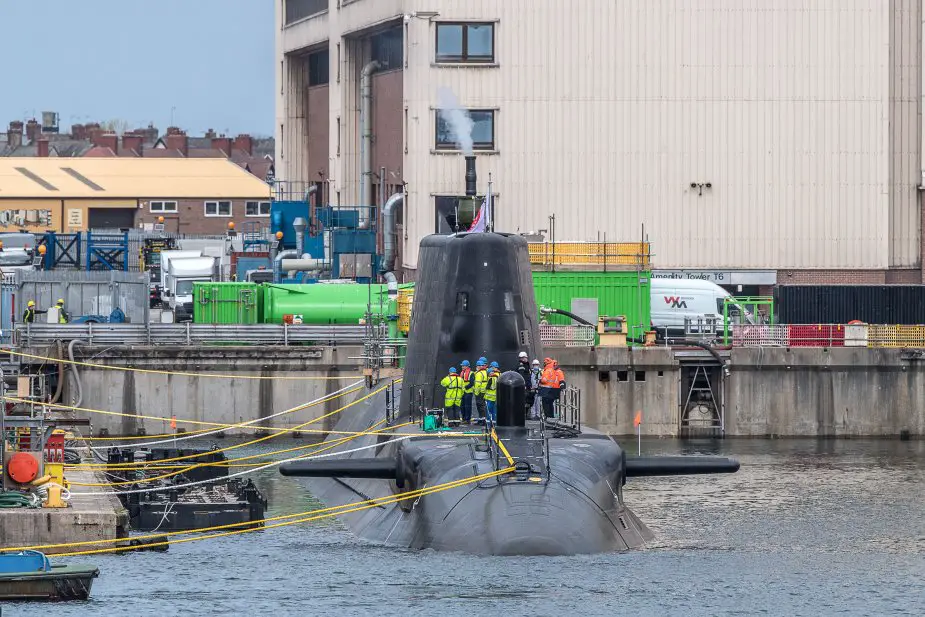According to information published by the Royal Navy on May 17, 2021, the fifth of the Silent Service’s Astute-class submarines sits in the water as she enters the final stages of construction and commissioning. HMS Anson was rolled out of her home for the past decade before being lowered into the water at BAE’s yard in Barrow during a delicate two-day operation.
Follow Navy Recognition on Google News at this link
 Astute-class submarine HMS Anson S123 (Picture source: Royal Navy)
Astute-class submarine HMS Anson S123 (Picture source: Royal Navy)
The Astute class has stowage for 38 weapons and would typically carry a mix of Spearfish heavy torpedoes and Tomahawk Block IV cruise missiles, the latter costing £870,000 each. The Tomahawk missiles are capable of hitting a target to within a few metres, to a range of 1,000 miles (1,600 kilometres). The Astute Combat Management System is a new version of the Submarine Command System used on other classes of British submarine.
The system receives data from the boat's sensors and displays the results on command consoles. The submarines also have Atlas Hydrographic DESO 25 high-precision echosounders, two CM010 non-hull-penetrating optronic masts—in place of conventional periscopes—which carry thermal imaging and low-light TV and colour CCD TV sensors. The class also mounts a Successor IFF system.
For detecting enemy ships and submarines, the Astute class is equipped with the sophisticated Sonar 2076, an integrated passive/active search and attack sonar suite with bow, intercept, flank and towed arrays. BAE claims that the 2076 is the world's best sonar system. All of the Astute-class submarines will be fitted with the advanced Common Combat System.
The boats of the Astute class are powered by a Rolls-Royce PWR2 (Core H) (a pressurised water reactor) and fitted with a pump-jet propulsor. The PWR2 reactor was developed for the Vanguard-class ballistic missile submarines and has a 25-year lifespan without the need for refuelling. As a result, the new submarines are about 30 per cent larger than previous British fleet submarines, which were powered by smaller-diameter reactors.
Like all Royal Navy submarines, the bridge fin of the Astute-class boats is specially reinforced to allow surfacing through ice caps. These submarines can also be fitted with a dry deck shelter, which allows special forces (e.g. SBS) to deploy whilst the submarine is submerged. More than 39,000 acoustic tiles mask the vessel's sonar signature, giving the Astute class improved acoustic qualities over any other submarine previously operated by the Royal Navy.
Astute is the second Royal Navy submarine class, after the Vanguard-class, to have a bunk for each member of the ship's company, ending the practice of 'hot bunking', whereby two sailors on opposite watches shared the same bunk at different times. However, they have less mess-deck space than the Valiant-class submarine built 45 years earlier. Since it is nuclear powered, the boat has theoretically unlimited endurance, though in practice it is limited to 90 days at sea based on food carried (including 18,000 sausages and 4200 Weetabix) and crew endurance.
The Astute class are designed to achieve a top speed of 29–30 knots (54–56 km/h), but it was reported in 2012 that this speed could not be reached in trials due to a mismatch between the reactor and the turbine. However, in January 2015, the National Audit Office confirmed that demonstration of the top speed requirement (or Key Performance Measure (KPM)) for the Astute class was successful.
HMS Astute, HMS Ambush, HMS Artful are already in service and were joined in April 2020 by HMS Audacious and operate from HMNB Faslane.



